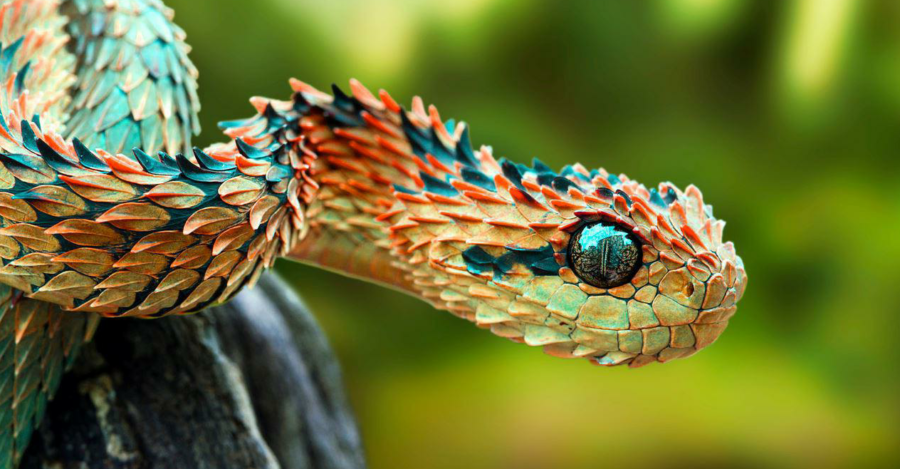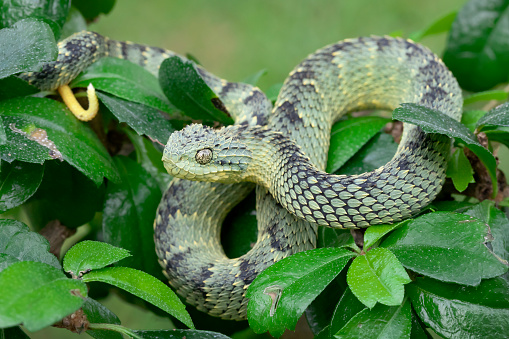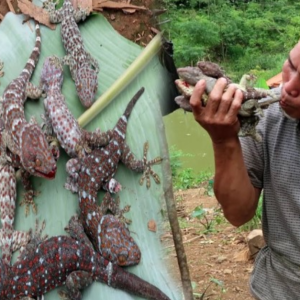Spiny bush vipers are part of class Reptilia and are native to central Africa. They can be found in tropical regions like rainforests. Their scientific name comes from the Greek words meaning hairy and tailed. These spiny-scaled, venomous snakes are relatively small and get their name from the keeled scales on their bodies. These creatures are also semi-arboreal, preferring to climb in trees for most of the day. Their venom is neurotoxic and can cause organ hemorrhaging, but toxicity varies with each individual.
/GettyImages-108350845-4270f5655ff6412ca918c7f9e575bd7c.jpg)
Fast Facts: Spiny Bush Viper
- Scientific Name: Atheris hispida
- Common Names: African hairy bush viper, rough-scaled bush viper
- Order: Squamous
- Basic Animal Group: Reptile
- Size: Up to 29 inches
- Weight: Unknown
- Life Span: Unknown
- Diet: Mammals, frogs, lizards, and birds
- Habitat: Rainforests, woodlands, swamps
- Conservation Status: Not evaluated
- Fun Fact: Spiny bush vipers have a prehensile tail, which allows them to hold onto branches or hang upside down.
Description
Spiny bush vipers are part of the family Viperidae and are related to venomous snakes like rattlesnakes and vipers found in tropical areas across Asia. They are small reptiles, only growing up to 29 inches for males and 23 inches for females. Males have long and slender bodies compared to the more stout bodies of females. Their bodies are covered in green or brownish keeled scales that give them a bristly appearance, earning them the name of spiny bush viper. The scales are longest at the head and slowly diminish in size as they go down the back. Their heads are triangular and broad, with narrow necks, short snouts, and large eyes with vertically elliptical pupils. Their tails are prehensile, which helps them to grasp, climb, and hang upside down.
:max_bytes(150000):strip_icc():format(webp)/GettyImages-517834287-3427f4bc585f49b38c3e8196cc0dea61.jpg)
The Hairy bush viper is a spectacular keeled tree viper species found in the DR Congo.
Habitat and Distribution
The habitat of spiny bush vipers includes rainforests, woodlands, and swamps. Because they are excellent climbers, they can often be found at heights between 2,900 and 7,800 feet. They are native to central Africa and are found in the Democratic Republic of Congo, southwest Uganda, Tanzania, and Kenya. Their distribution has been described as isolated populations across these regions.

Diet and Behavior
These snakes feed on small mammals, birds, lizards, and frogs. They hunt mostly in trees but can hunt for mammalian prey on the ground. They ambush their prey by hanging from trees or hiding in foliage and curling up into an S-shape before lunging at prey, killing them with their venom. Spiny bush vipers are nocturnal creatures, spending the daytime basking on top of flowers in small trees about 10 feet off the ground. They may also climb reeds and stalks, but they prefer the terminal leaves and flowers of smaller trees.

Reproduction and Offspring
Mating season for spiny bush vipers occurs during the rainy season between the end of summer and October. They reach sexual maturity between 2 and 3 years of age. Females are ovoviviparous, meaning they give birth to live young. After mating, females carry their fertilized eggs in their bodies for 6 to 7 months before giving birth to 9 to 12 young at a time in March or April. These young are about 6 inches in total length and are dark green with wavy stripes. They attain their adult coloration after 3 to 4 months. Due to their remote location from humans, scientists do not know their life span in the wild, but these creatures can live more than 12 years in captivity.
Conservation Status
Spiny bush vipers have not been evaluated by the International Union for Conservation of Nature (IUCN). Not much is known about their population due to their remote location and their nocturnal activity.
Spiny Bush Vipers and Humans
:max_bytes(150000):strip_icc():format(webp)/GettyImages-1090273418-4e9e70f5776942d5ba2c248a2d24f2c8.jpg)
Venomous Hairy Bush Viper Snake (Atheris hispida) in tree.
Due to the remote locations of these snakes’ habitats, there is not much interaction with humans. Their venom is neurotoxic and can result in serious hemorrhaging of internal organs. If bitten by this viper, it can cause pain in the local area, swelling, and bleeding in more serious cases. Toxicity varies depending on the snake, the location of the bite, and even the current weather and altitude.
Like all Atheris species, there is currently no specific antivenom, and without access to first aid, a bite can be fatal to humans. However, bites are relatively rare due to their remote location and nocturnal habits.





